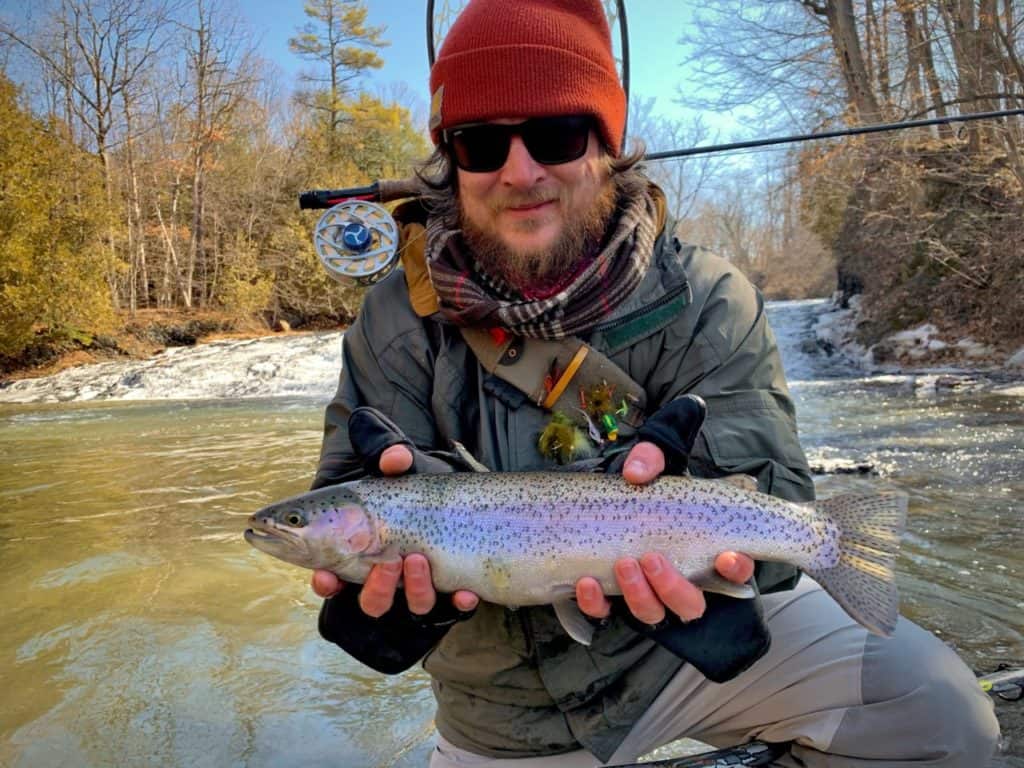
Officials recommend fishing low and slow
Vermont’s traditional trout fishing season opens Saturday, April 10, and despite lingering snow cover, the Vermont Fish & Wildlife Dept. says anglers can still have fun and be successful early in the season while following Covid-19 safety precautions.
“Just like any other time of year, anglers fishing early in the spring should adjust their tactics based on conditions,” said State Fisheries Biologist Shawn Good. “Trout will become more active with warmer water temperatures, and despite an early spring, most streams and rivers are still quite cold. But if you can find a good location and present your bait or lure without spooking the trout, you can enjoy getting outside and you have a good chance of catching a few fish.”
“Finding a small to medium low-elevation river or stream that is not too murky from spring runoff can be key. Trout are coldblooded and may be slow to bite especially with low water temperatures, so it’s important that they can also see your bait, lure or fly.”
Larger baits can often be more effective for enticing early-season trout into biting. Spin-anglers should try nightcrawlers, egg imitations, or bright colored spoons and spinners. Fly anglers may find success in the early season by drifting large, more visible flies such as wooly buggers, streamers, or San Juan worms along the bottom in slower pools and runs.
Trout will often hold close to the bottom in the deeper areas of streams during high flow conditions to conserve energy. Choose locations and tactics that allow you to fish using a slow retrieval right along the bottom. Focus on deep holes behind current breaks created by big boulders, downed trees or log-jams where trout may be resting. If possible, approach the hole from downstream as trout will often orient themselves facing the current.
While Vermont offers excellent and diverse fishing opportunities for wild trout, stocking also occurs in many streams and rivers where wild trout populations are low or absent. This generally happens between May and June each year following spring runoff.
“Early in the season, like on opening weekend, you’ll probably have more success if you focus on waters known to hold wild trout,” said Good. “Despite unpredictable weather during early spring, each year anglers report catching impressive trout during opening weekend.”
Anglers who like to fish and release their catch don’t need to wait for opening day. There are year-round catch-and-release fishing opportunities for trout and bass in Vermont. See page 31 of the 2021 Vermont Fishing Guide and Regulations for a list of rivers open to year-round trout fishing. The Guide is available from license agents and it is on VTF&W’s website at this link: eregulations.com/vermont/fishing/
The guide is a helpful tool for planning a fishing trip as it includes maps showing rivers and lakes, as well as fishing access areas and public lands for fishing and hunting. It also lists the fish species found in each body of water.
The Fish & Wildlife Dept. urges anglers to use good judgement to keep everyone safe and reduce the spread of the coronavirus:
- Refrain from carpooling. Drive to your fishing spots only with your immediate family members and only if everyone is feeling well.
- When fishing from shore, keep a distance of at least six feet between you and your companions. A good way to measure this is with your fishing pole! Hold the pole straight out in front you. If you can turn in a circle without hitting anyone, that is a safe distance.
- Don’t share fishing gear with others. Each angler should have their own fishing gear (rod and reels, bait, lures, towels, pliers, and other personal items).
- Avoid touching your eyes, nose, and mouth.
- Clean your gear well after using it.
- Wash your hands for at least 20 seconds with soap and water after fishing.
For information about staying safe while enjoying outdoor activities, check here:
vtfishandwildlife.com/covid-19-related-information.




